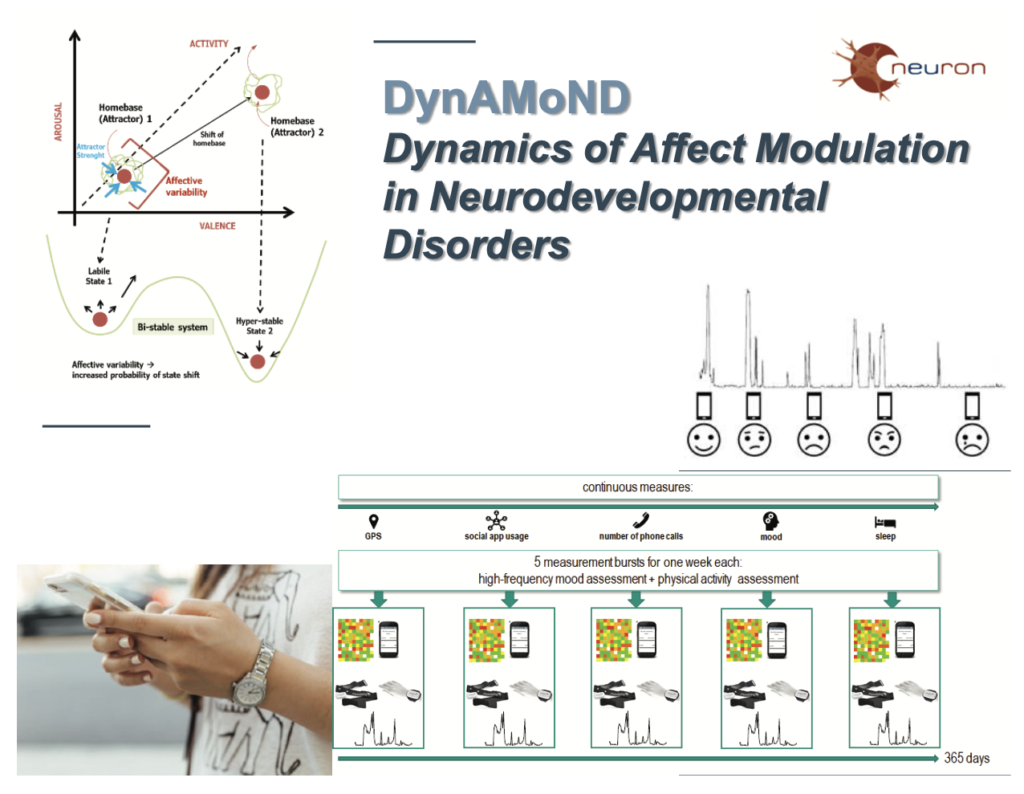
About
DynaMonD
Dynamics of affect Modulation in neurodevelopmental Disorders
Background
Attention deficit/hyperactivity disorder (ADHD) is the most frequent neuro-developmental disorder, with high persistence into adulthood, where it is often comorbid with bipolar disorder (BipD) and Borderline Personality Disorder (BPersD). Whether this is due to shared pathophysiological mechanisms is unclear. All three disorders are characterized by long- or short-term fluctuations in affective states; in BipD, these are low in frequency but high in amplitude, while in ADHD and BPersD, mood and emotional state are more dynamic. Whether the more episodic mood fluctuations, occurring in BipD, and short-term affective states in BPersD and ADHD are distinct phenomena or rather ends of a spectrum is yet unclear.
The model adopted in this project

The DynAffect Model assumes that three dynamical properties of affect dynamics, namely the homebase (attractor of the dynamic system), affective variability, and attractor strength, are capable of explaining individual differences in temporal patterns and trajectories. Basically, affective dynamics can be described by the homebase (people having most often good or bad mood), their variability (which is the amount of reactivity to external and internal events) and their attractor strength (i.e., how strong or rigid affective variability is regulated back to the attractor; Fig. 1). It is important to mention that the DynAffect Model was developed in the field of basic affective science, where variability is seen usually as a positive feature while excessive variability is mainly unknown. However, the latter is the dominant phenomenon in BPersD and ADHD (often labelled as “affective dysregulation”). We extend DynAffect by proposing that, while developing a major mood episode (depression or mania), the homebase itself moves from one place in this two-dimensional space to another, returning to the original homebase upon remission. These two homebases can be interpreted that way that affective dynamics can occur in the form of a bistable system, where e.g. depression and euthymia can be described as double well potentials with reduced variability during depression. Excessive variability, as found in ADHD and BPersD, increases the likelihood to drive the dynamics from one to the other homebase (=attractor) in such a bistable system. This interpretation opens the possibility to intervene effectively when the system oscillates in the desired direction. In the following, this hypothesis is called Modified DynAffect Model. The neurobiological mechanisms underlying these dynamics are unclear. Since its deployment, the DynAffect model has been successfully used in patient with BPersD, but studies applying it to ADHD or BipD are missing.
Aims
Our main objective is to test whether the dynamics of mood fluctuation as proposed by the Modified DynAffect Model (homebase, variability, strength), differ between ADHD, BipD and BPersD, and from neurotypical controls will be (1) to characterize all components of the Modified DynAffect Model, namely homebases, variability and attractor strength (shared and specific) in ADHD, BipD and BPersD, (2) to investigate the influence of stressor exposure (both macro- and micro-stressors, measured with high granularity) and sleep therein (3) to examine the contribution of polygenic risk factors for Depression, ADHD, BipD, BPersD, Neuroticism, and Resilience therein.
To carry out these objectives, we will carefully characterize patients clinically, and densely measure affect fluctuations using EMA and established online tools.
Duration
36 months